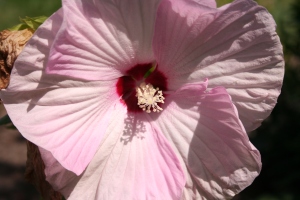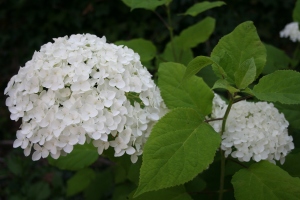From the wide range of plants flowering in our garden, “H” seems to be the letter of the day; it is also the birthday of my Father, Henry, who at 85 is still as keen a gardener as he was when he ran his nursery and flower farm in Cornwall, south-west England.
Of the several hundred species of Hibiscus most gardeners are familiar with, Hibiscus rosa-sinensis, is a tropical species, the national flower of Malaysia and a house plant in our climate. The other common species, Hibiscus syriacus, is hardy in Europe but comes from Korea where it too is the national flower. While both the French (Minier) and the English (Notcutts) have been growing and breeding this species since the 17th C and the Washington National Arboretum created the first triploid forms, some of the more interesting newer varieties are coming from its country of origin. Hibiscus syriacus grows easily here and many gardeners train it as a flowering hedge. Neighbours keep giving us self-sown seedlings to try but two of our newer named varieties are double flowered Purple Ruffles and semi-double, white with red China Chiffon.
A third Hibiscus form is becoming increasing popular: hybrids of the American the Swamp Hibiscus, H. moscheutos and similar species, which feature very large flowers in a range of colours. Fleming Brothers of Lincoln, Nebraska (USA) are well known breeders of this plant while the Sakata Seed Corporation in Japan was also involved from the 1960’s onwards. The big difference between these and H. syriacusis that they are herbaceous: they die down every autumn and regrow the following year. I have bought and planted a couple of colours from a grower at the local market but, as is so often the case here, he was unable to tell me there names. Perhaps they were a mix batch of seed raised plants but I was told they were from cuttings so I may eventually be able to identify them. As implied by the common name, while they like good sunshine they also require moist soil. I have chosen two sites with slightly different conditions to see where they do best.
Hydrangea macrophylla varieties have been flowering for some while and now our H. paniculata are blooming. Kyushu has huge, rounded heads of white flowers which bend towards the ground under the weight. Great Star was a discovery from the renowned French garden of Princess Sturdza, Le Vasterival at Varangeville-sur-Mer, a few miles west of Dieppe in Normandy. The flowers open to large, white, wavy, star-shaped florets that can be up to 4″ in width.
I am a great fan of Hebe and of the 1001 gardens I have designed over the years few cannot have had a Hebe Great Orme in some prominent position. After its third year with us, ours is finally producing flowers in the quantities we are used to. Our other Hebe, in the White Border – a shadier spot than Great Orme was given – has flowered more quickly. This is H. Kirkii, a natural hybrid between Hebe salicifolia and Hebe rakaiensis which was discovered in 1868, near Canterbury on New Zealand’s South Island and was named after botanist Thomas Kirk.
We grow a number of Hemerocallis (Day Lilies) in a range of colours and these have being flowering for several weeks. One clump was recovered from the side of the road where someone had dumped it, but most are named varieties including Cream Drop, Burning Daylight, Royal Red, Vanilla Fluff and Congo Coral. This is the theory: in fact, some of the plants are not flowering anything like the colour expected and I suspect a mix-up at the nursery…..either that, or they ran out of one variety and bunged us what they had left. In the dry conditions we are experiencing they have needed regular watering but have produced spectacular amounts of flower, whatever the colour.
Last on the list is Hosta, a plant we grow few of, lacking the water margin conditions they prefer. Variegated Great Expectations was said to be challenging to grow but has done well here, while a large patch of Hosta ‘Guacamole’ surrounds our Japanese granite bird bath. This variety is a sport of ‘Fragrant Bouquet’ and has huge, glossy, apple green leaves surrounded by streaked, dark green leaf margins just like an avocado. Flared flowers are appearing now: pale lavender and very fragrant.



hello! you’ve got nice hisbiscus there. i love hydrangeas too. happy birthday to your father! have a nice day!
Hi and thanks…..comments always welcome. Please “like” us to encourage more people to drop in and say “hello”.
Every time I see a picture of a Hebe plant I wilt with desire. Any of them, and there are a lot to choose from it seems. Unfortunately they are not hardy enough where I live. Please post some photos of your hebes.
Do the french call hebes something different ?? i cant seem to find it on any nurserys websites in france !
Yes, they use the old name “Veronica” as well as the Latin name Hebe.
http://www.jardiland.com/vente-en-ligne/pepiniere/4290-hebe-great-orme.html